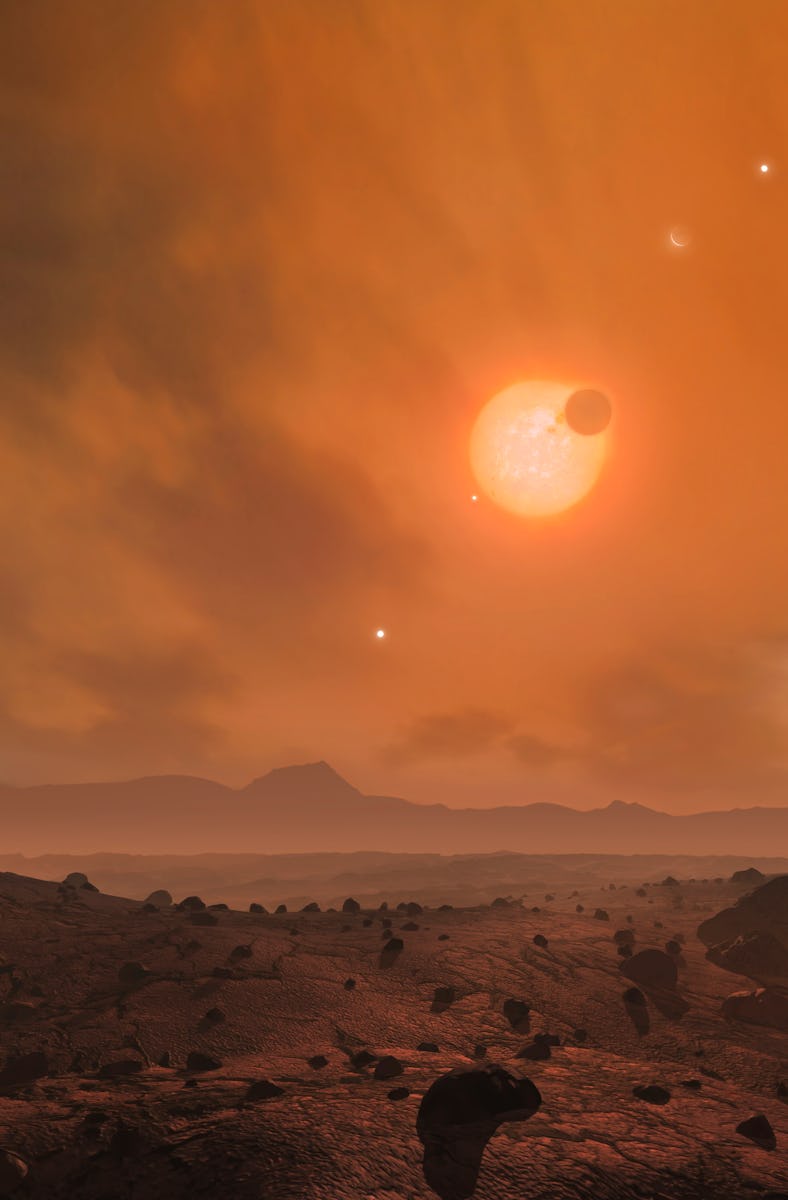The Best Way To Find Alien Civilizations May Be To Search For Their Pollution
If life on TRAPPIST-1e has industry, we could see its chemistry at work.

If there’s life on any of the habitable-zone TRAPPIST-1 worlds, JWST should be able to see signs of it in the planet’s atmosphere, a recent study says.
The reverse is also true; if an alien civilization out there somewhere has their own super-sensitive infrared space telescope, they’ll be able to see our effects on our planet’s atmosphere. Johns Hopkins University astrobiologist Jacob Lustig-Yeager and his colleagues turned measurements of Earth’s atmosphere into simulated data from TRAPPIST-1e and found that even in the messy, low-resolution view of a planet 40 light years away, JWST could pick out molecules that reveal the presence of life and advanced technology (by which we mean pollution).
They published their work in a pre-print paper, which has not yet been peer-reviewed.
Telltale Signs of Life
To test whether JWST’s instruments could spot traces of industrial pollutants like chlorofluorocarbons (CFCs) in the atmosphere of a planet orbiting another star, Lustig-Yeager and his colleagues had to make real data from Earth’s atmosphere look like it came from a planet 40 light years away.
Canada’s SCISAT orbits the only planet we know of with CFCs and other pollutants in its atmosphere: Earth. Every time Earth passes between the satellite and the Sun, SCISAT’s two instruments measure the spectra of sunlight filtering through Earth’s atmosphere and identify the chemicals in the air. According to SCISAT, our planet’s atmosphere is full of signs of life, like oxygen and methane, but it’s also laden with pollutants like carbon dioxide and CFCs. Air pollution is bad news, of course, but it’s also a sign that an intelligent (if not especially sensible) species has developed some advanced technology.
CFCs, in particular, would be a dead giveaway, because they aren’t produced by natural processes. Here on Earth, CFCs were used as coolants, propellants, and solvents from the 1920s to the late 1980s. Their presence would almost certainly be thanks to aliens advanced enough to create artificial chemicals and pollute their atmosphere.
But we already know there’s a technological species here on Earth. If alien civilizations managed to send a probe to our Solar System, they’d have no problem seeing the evidence in our atmosphere. Lustig-Yeager and his colleagues wanted to know whether the same evidence would show up from a few dozen light years away. The answer turns out to be yes.
Simulating the View from TRAPPIST-1
Lustig-Yeager and his colleagues took the SCISAT data and made a mess of it until it looked more like the noisy, low-resolution view astronomers get when they point JWST at the tiny sliver of atmosphere around an alien planet passing in front of its distant star.
First, the team simulated what SCISAT’s view of Earth’s atmosphere would look like if the satellite were perched at the far edge of our Solar System instead of in low-Earth orbit. Next, they added a bunch of “noise,” or random bits of infrared light that don’t come from the star or the planet. Finally, they took samples of this noise-cluttered data at a much lower resolution, similar to how JWST would see a planet 40 light years away.
In this messy, low-resolution data from a planet’s atmosphere, the team could still pick out chemicals that revealed the presence of life and technology. That suggests that if there are aliens building cities and factories on TRAPPIST-1e, JWST will probably be able to see the telltale signs in the planet’s atmosphere. And if there are aliens on TRAPPIST-1e with powerful space telescopes, they can probably tell the same thing about us.
Of course, that’s assuming TRAPPIST-1e, or any planet like it, actually has an atmosphere at all. Results from the two innermost TRAPPIST-1 worlds are discouraging, although a recent study suggests there’s still hope. In the coming year, Cornell University astronomer Nikole Lewis and her colleagues plan to take a look at TRAPPIST-1e, where they hope to find the signatures of chemicals like carbon dioxide, oxygen, water vapor, and maybe even methane.